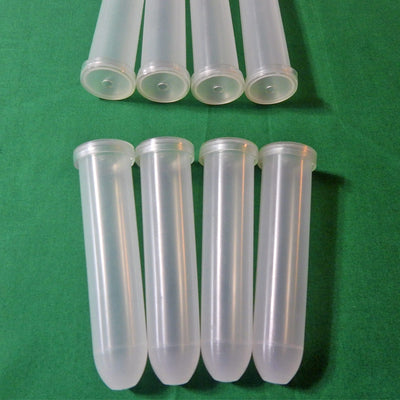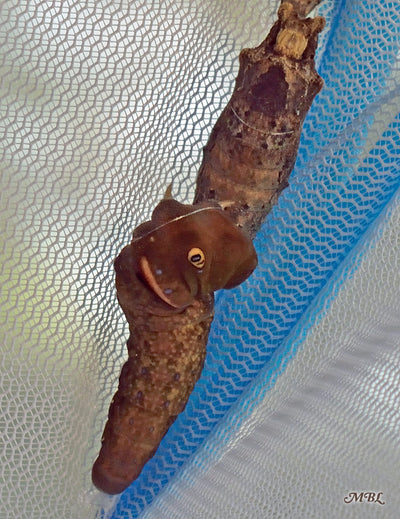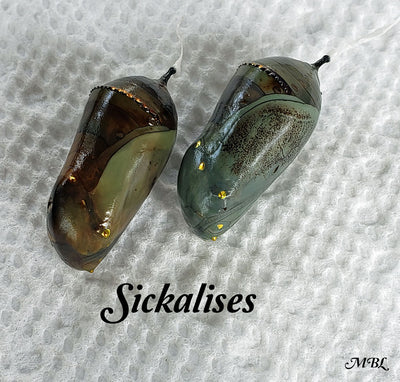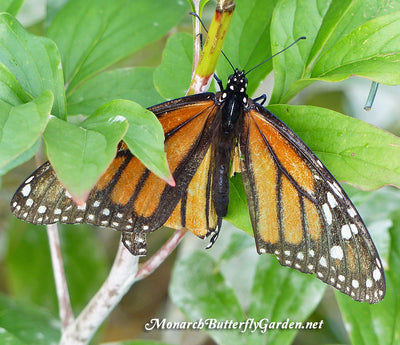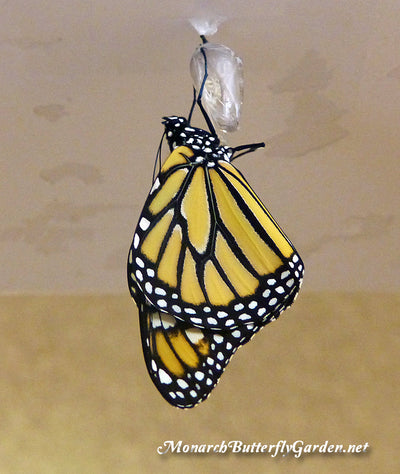Raising Butterflies Blog
How to Overwinter a Swallowtail Chrysalis until Spring?

Overwintering Black, Giant, & Tiger Swallowtails

Some butterflies, like monarchs, migrate to warmer regions for the winter, while others are left behind to brave the winter weather in various stages of the butterfly life cycle.
This includes the woolly bear (Isabella tiger moth) caterpillar, mourning cloak butterfly, and the swallowtail chrysalis…
5 Steps for Overwintering Swallowtail Chrysalides
1. Find a suitable cage for overwintering
I used to believe that swallowtails needed to pupate on sticks. Turns out, they’re just fine forming their chrysalis anywhere: in the pop-up mesh raising cage, on cuttings containers, on their host plants, or even here:

We don’t raise many swallowtails so our overwintering broods are typically less than 5 total…a small pop-up cage is all that is needed. If you overwinter larger broods, you can can still fit them in a small enclosure by removing and relocation them.
If you choose to remove chrysalides consider this technique & set up for your overwinter guests:
a. Allow the chrysalis to dry for 48 hours before relocating.
b. Cut the girdle (two single strands of silk that are holding the chrysalis middle on each side) with a scissors or hand pruner. This will leave the chrysalis attached only from the bottom

If it’s too difficult to reach the girdle, just skip this part and proceed to part c…
c. Spray the chrysalis with water at the bottom where it’s still attached to the stalk, cage, container, etc. to allow for easier removal
d. Wait for about 30 seconds after spraying before removing.
e. Gently pull on the chrysalis to remove it. If you’re not able to remove without applying pressure, try spraying the attachment point again.
removal tip: if you’re wondering how we removed Eddie from the egg carton hole above, we cut open the carton, for easier access to the chrysalis. We used egg cartons to hold floral tubes with prickly ash (or other host plant) stem cuttings. Now we use floral tubes with racks for feeding caterpillars.
f. Place paper towels across the cage floor and then set the chrysalides by a mesh wall…the paper towels will collect any meconium (metabolic waste) the swallowtails expel when they emerge in spring.

While monarchs can be a bit lethargic emerging from their chrysalides, swallowtails are more active and typically won’t have any problems crawling up the mesh wall to dry their wings
 Crawl Up The Wall
Crawl Up The Wall8 of 9 giant swallowtail chrysalides pictured above had happy endings with 8 healthy butterflies emerging in Minnesota between May 10-17. All 8 butterflies had no issues crawling up the mesh wall to dry their wings. The 9th died in-chrysalis sometime over winter…
2. Find a suitable spot to keep the cage overwinter
If you keep a swallowtail chrysalis indoors, expect some butterflies before the holidays…and I don’t mean Easter!
Temperature plays a major role in deciding when your butterflies will emerge. We keep ours in a 3-season porch where temps are only a few degrees warmer than the wintry outdoors.
I keep the cage on the north side of the porch, where it gets less sun. I suspect they could eclose prematurely if placed on the sun-soaked south side.
Many raisers report success overwinter swallowtails in their garage. Predators like mice/rats 🐭 have been reported to chew their way into cages to devour chrysalides, so make sure they’re in a safe place.

If you can’t provide a suitable overwintering space, you can also try overwintering swallowtail chrysalides in your refrigerator
For more info and discussion about where to overwinter swallowtail chrysalides try the Simply Swallowtails Facebook Group
3. Give each swallowtail chrysalis adequate moisture for the winter
Based on my experience with monarchs, I believe it’s most important to hydrate your caterpillars. However, it can take a swallowtail months to emerge from its chrysalis, so…
Once a month (on days where the temps are above freezing) I mist the chrysalides with water. I have no scientific evidence that proves this helps. However, common sense tells me it’s not good for swallowtail chrysalises to be kept inside without access to moisture they’d naturally receive outdoors.
4. Be Patient
Swallowtails aren’t on a monarch timetable, though all of our overwintering Minnesota swallowtails have emerged in April & May. An overwintering swallowtail chrysalis can take months to eclose (hatch), and I’ve heard reports of butterflies emerging after more than a year in the pupal stage.
I would give them the entire season before discarding, but I would not overwinter them twice.
I have heard that spraying weekly (or even daily) in the summer coaxes the butterfly to eclose, but this info is only based on a few first-hand reports. Regardless, a little extra water isn’t going to hurt them (with good air circulation) and will keep them from drying out.
5. Let butterflies dry thoroughly before releasing

You can place them outside to safely 🌞 dry in a mesh cage for an hour or so. This way, no predators can attack while they are flightless and defenseless. Then open the cage door, and let them fly free to start a new season of swallowtails.

We have raised black swallowtails, tiger swallowtails, and giant swallowtails, but these overwintering swallowtail chrysalis tips should work for other swallowtail species too...Happy Raising!

